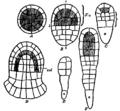Smooth hornwort facts for kids
Quick facts for kids Smooth hornwort |
|
|---|---|
 |
|
| Scientific classification | |
| Genus: |
Phaeoceros
|
| Species: |
laevis
|
| Synonyms | |
|
Anthoceros laevis L. |
|
Phaeoceros laevis, also known as the smooth hornwort, is a type of hornwort plant. It belongs to the Phaeoceros group. You can often find this small plant in places that have a lot of moisture. This includes damp soils in fields, along the edges of streams and rivers, or even underwater in rivers.
Smooth hornworts usually grow to be about 5 millimeters tall. These plants have both male and female parts on the same plant. These parts are visible on the top surface of the plant.
Contents
What is a Smooth Hornwort?
The main body of the smooth hornwort is called a thallus. It looks almost flat on its top surface. This plant has a dark green color and a slightly shiny look. Inside the plant, there are no empty spaces between its cells.
How Does It Look?
The hornwort's capsule, which holds its spores, can be from 6 to 18 inches long. The bottom part of the capsule is surrounded by a tube-like cover. This cover often widens at its opening.
The spores of the smooth hornwort are yellow. They have a bumpy or grainy surface. The elaters, which help spread the spores, are yellowish and often have branches. They come in different sizes and shapes. When many of the thin green capsules grow together, they can look like small clumps of grass. To tell exactly what species a hornwort is, you need to look at its mature spores.
How Scientists Study Smooth Hornworts
Scientists have studied the cells of Phaeoceros laevis a lot. This is called cytology. In 1909, a scientist named Lotsy found something interesting. He reported that each cell in the plant's main body (the gametophyte) had one chloroplast. Chloroplasts are like tiny factories that make food for the plant using sunlight. He also found that each cell in the spore-producing part (the sporophyte) had two chloroplasts. The sporophyte looks like a long, thin shape.
Cell Division and Structures
Later, in 1924, Lorbeer discovered more about these cells. He saw that when a cell was dividing, it had two plastids. Plastids are parts of plant cells that store things or make food. McAllister also noted that these plastids could be different sizes.
The centrosomes of the smooth hornwort are also special. Centrosomes help cells divide. Just like in another plant called Marchantia polymorpha, the centrosomes in P. laevis have two centrioles. These centrioles are connected end-to-end.
Images for kids
-
Phaeoceros laevis (D). Illustration from the 1911 Encyclopædia Britannica


